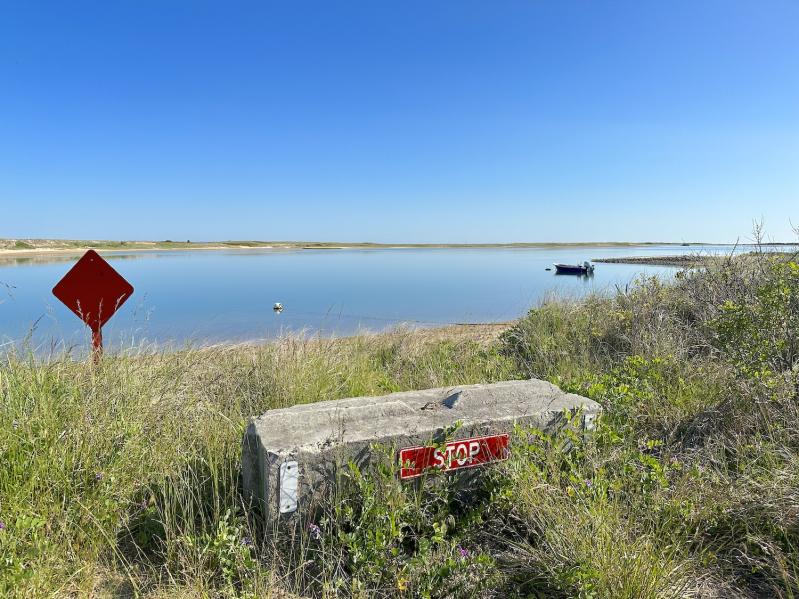Members of the East Hampton Town Trustees met via video conference with officials of the Peconic Estuary Partnership and other groups last week, regarding a study that would help determine whether and how to improve water circulation in Napeague Harbor. The trustees have long pressed for a solution, which could be funded in part with money from the host community agreement between the town, the trustees, and the developers of the South Fork Wind farm. That agreement includes almost $29 million flowing to the two entities over 25 years.
Meeting in the Old Town House, a 1731 structure on the grounds of Clinton Academy, as part of the town’s 375th anniversary observance, the trustees pondered the next steps toward restoring the harbor to ecological health, referring in part to a 2012 report that detailed conceptual designs.
Restoring the east inlet, which closed in 2007 after an April northeaster, would improve water quality and habitat for shellfish, finfish, and eelgrass. It would also reduce water flow through the west inlet, and, potentially, shoreline erosion north of Lazy Point and on Promised Land.
“The conclusion that restoration of tidal flow through the east inlet would provide ecological benefits was based on observations by the Town’s Natural Resources Department,” the report stated, “indicating increased shellfish production at the town’s shellfish grow-out facility and increased eelgrass abundance in years immediately following the excavation of a small channel near the historic east inlet location, compared to years when the east inlet was entirely closed.”
Since that report, however, not only have eelgrass beds been in sharp decline, but for the last four years bay scallop populations have suffered a substantial die-off. Warmer water is understood to be among multiple stressors for both, and it is hoped that increased circulation with cooler ocean water will alleviate conditions in the harbor. “Apparently, the water temperature is starting to go way up,” Bill Taylor, a trustee, told his colleagues. “If what we come up with is leaving it like it is, that’s just going to keep on going.”
The 2012 report stated that “a restored east inlet constructed through the removal of 60,600 cubic yards of sediment would be sufficiently large to capture a significant fraction of the Napeague Harbor’s tidal flow. Considering that Napeague Harbor can only support one stable inlet, east inlet restoration would either require or cause the closure of the west inlet.”
“This is definitely going to be a Type I SEQRA action,” John Aldred told the trustees, referring to the New York State Environmental Quality Review Act. A Type I action presumes significant environmental impact and requires completion of a environmental impact statement. “Permitting would be extensive,” Mr. Aldred said, requiring the participation of many groups, among them the Army Corps of Engineers, the D.E.C., the State Office of Parks, Recreation, and Historic Preservation, the town, “and probably a lot more.”
Mr. Aldred sketched out a four-step process: a hydrodynamic study, described as a feasibility study; engineering and permitting, including the environmental impact statement; construction, and maintenance.
In the 2012 report, the hydrodynamic study was estimated to cost $250,000. It is now more likely in the $300,000 to $600,000 range, Mr. Aldred said. “That only gets you to the point where you have a lot of the information we need to make the decision to move forward. Then you have to get into getting engineering plans drawn up, and then that leads in to the permitting process. . . . We’re probably talking many hundreds of thousands, if not millions, of dollars at that stage.”
Construction would likely require millions more, he said, as would maintenance, which he described as “the critical component of this.” Unless Suffolk County could be persuaded to “put a significant effort to long-term maintenance, this would be largely our responsibility, or whoever the partners were who undertook this.”
It was understood at last week’s trustee meeting, said Jim Grimes, that “it was going to be a project beyond the scope of what the trustees on their own could finance.” Potential partners include some of the aforementioned permitting agencies as well as “the resident communities of Napeague, some of the other property owners that could potentially benefit from the disposition of spoil from this project.”
“It’s going to take many hands to lift this,” Mr. Grimes said.
The trustees agreed that defining the scope of, and partners in, the proposed project was a necessary first step. Would they rely on a single engineer’s report or solicit a range of opinions? Would they seek to partner with the town or the Peconic Estuary Partnership? That “would lend a certain amount of legitimacy that going it alone wouldn’t, necessarily,” Mr. Aldred said of a partnership.
As a next step, it was agreed, every trustee will study a synopsis of the meeting, once the estuary partnership has distributed it.
The trustees, who typically meet at 6:30 p.m. on the second and fourth Monday of each month, also agreed last week that holding their first September meeting on the 11th would be inappropriate, given that it falls on the anniversary of the 2001 terrorist attacks on the World Trade Center and the Pentagon. Instead, that meeting will happen on Sept. 8, with an executive session beforehand to discuss their ongoing inventory of docks and other waterway structures under their jurisdiction.




